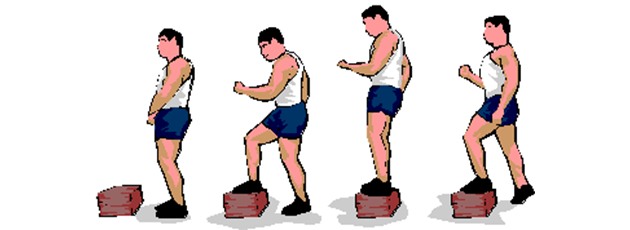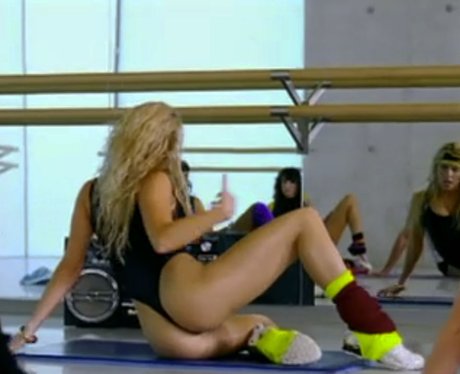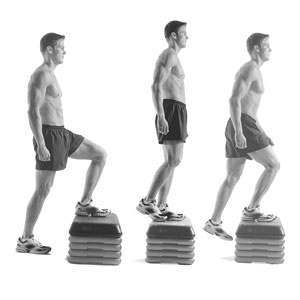
There are two exercises that have the lamest of lame connotations when I think of them. Maybe you too. The step-up and the clamshell. At least when I think of the clamshell, I think of the Eric Prydz Call On Me video:

But the step-up. Holy hell what a lame exercise, right? Invariably you see it demonstrated like this:

How many repetitions do you think our friend would have to complete to affect a stimulus? My guess is somewhere between 1500 and 15,000.
Almost any time you have an exercise that seems lame or ineffectual, you can find out if that’s true or not by making it heavier. When it doubt, go really heavy.
What happens when you go really, really heavy on a step-up? You get:
- Massive core stability demands due to the offset position and asymmetrical force transfer.
- Huge end range hip extension requirement.
- Less ankle dorsiflexion requirement than a comparable squat – can be good for people with poor ankle movement.
- Depending on the loading position & implement, upper back recruitment comparable to a similar squat or carry.
- Less lower back stress than a squat or a deadlift due to the more upright torso position.
You’ll find many people raving about heavy carries and for good reason. Ambulating with a heavy load is a fantastic way to build strength in a useful, usable range of motion. Heavy step-ups are like dialing carrying up to 11, and I think they’re an underrated strength exercise.
If you have access to one my favorite way to do heavy step-ups is with a safety squat bar. The next heaviest option is in a back squat position. Finally, if you want to work on your grip strength or you already have ferocious grip strength then very heavy kettlebells or dumbbells can be a good option as well.
It seems like a simple exercise, and it is, but there is a coaching point that I think is useful that I picked up from Nick Tumminello. In short, Nick teaches to lean forward onto the working leg, and then lift the heel on the non-working leg. This combined with driving through the heel of the working leg virtually eliminates the cheating, double-leg step-up you often see.
Here is a guideline I tell my gym members when it comes to the relationship between box height and weight:
If a tall box tests well, go lighter.
If a short box test well, go heavier.
Tall-light, short-heavy.
Different heights have different benefits and are in many ways very different movements from each other. Do what tests the best.
Get it on with some heavy step-ups and let me know what it does for you.
Here’s a demo of a heavy-ish set:


Low box step-ups work awesome for a replacement to loaded carries around a crowded gym (or if space is limited in other ways) as a conditioning tool.
I do like these when I do them, but I especially like your tall-light, short-heavy cues – never thought of it quite like that, but will do so going forward. I also like Nick’s tip on eliminating the cheating. While I have done them by lifting the toes up on the non-planted leg, I never have tried a bit of lean on the planted one. Will do these soon – thanks!
Thanks for blogging about this. Step-ups are great! A very good whole-body exercise. I started doing loaded carries outdoors, after reading this entry from Dan John: http://www.t-nation.com/free_online_article/most_recent/the_secret_of_loaded_carries
I used heavy dumbbells fitted with kettlebell handles, and started doing farmer’s walks outside. The real fun began when I played with different gradients, walking uphill, downhill and on slopes both right and left to my direction of travel. Figure-eights, walking backwards, and of course – both UP stairs and DOWN. It’s the downwards part that may be difficult to get in a gym, and probably not with barbells. I can highly recommend stepping both up and down (in front) from a low box; high boxes would likely strain the knees too hard for it to be worth it (quoting Coach Dos; always assess risk vs. gain for any exercise). A decent flight of stairs is even better, you get that lovely contra-lateral flow of stability from side to side, a very functional sequence if you care about that (you should). Keep bringing the good stuff!
Interesting! I never even thought about training this movement.
Was kind of surprised to see the lifter step backwards with the left leg on every rep.
Heavy carries are great. I find weighted walking lunges work really well. Performing a kettlebell swing works your grip really well also. The arc of the swing tries to pull the kettlebell out of your hand, so you don’t need too heavy a weight to work your grip! Rep them out, sets of 20, and you should be feeling it!